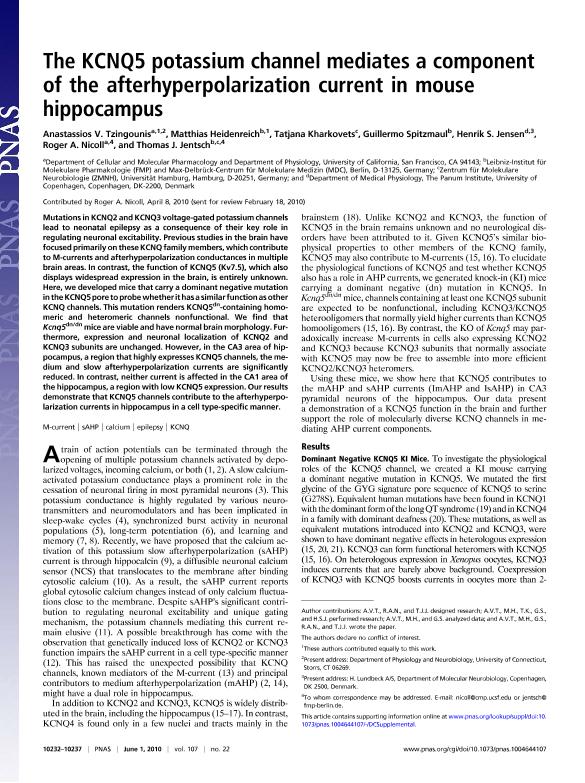Mostrar el registro sencillo del ítem
dc.contributor.author
Tzingounis, Anastassios V.
dc.contributor.author
Heidenreich, Matthias
dc.contributor.author
Kharkovets,Tatjana
dc.contributor.author
Spitzmaul, Guillermo Federico

dc.contributor.author
Jensen, Henrik S.
dc.contributor.author
Roger, A. Nicoll
dc.contributor.author
Jentsch, Thomas J.
dc.date.available
2019-05-17T20:22:12Z
dc.date.issued
2010-06-01
dc.identifier.citation
Tzingounis, Anastassios V.; Heidenreich, Matthias; Kharkovets,Tatjana; Spitzmaul, Guillermo Federico; Jensen, Henrik S.; et al.; The KCNQ5 potassium channel mediates a component of the afterhyperpolarization current in mouse hippocampus; National Academy of Sciences; Proceedings of the National Academy of Sciences of The United States of America; 107; 22; 1-6-2010; 10232-10237
dc.identifier.issn
0027-8424
dc.identifier.uri
http://hdl.handle.net/11336/76672
dc.description.abstract
Mutations in KCNQ2 and KCNQ3 voltage-gated potassium channels lead to neonatal epilepsy as a consequence of their key role in regulating neuronal excitability. Previous studies in the brain have focused primarily on these KCNQ family members, which contribute to M-currents and afterhyperpolarization conductances in multiple brain areas. In contrast, the function of KCNQ5 (Kv7.5), which also displays widespread expression in the brain, is entirely unknown. Here, we developed mice that carry a dominant negative mutation in the KCNQ5 pore to probe whetherit has a similar function as other KCNQ channels. This mutation renders KCNQ5dn-containing homomeric and heteromeric channels nonfunctional. We find that Kcnq5dn/dn mice are viable and have normal brain morphology. Furthermore, expression and neuronal localization of KCNQ2 and KCNQ3 subunits are unchanged. However, in the CA3 area of hippocampus, a region that highly expresses KCNQ5 channels, the medium and slow afterhyperpolarization currents are significantly reduced. In contrast, neither current is affected in the CA1 area of the hippocampus, a region with low KCNQ5 expression. Our results demonstrate that KCNQ5 channels contribute to the afterhyperpolarization currents in hippocampus in a cell type-specific manner.
dc.format
application/pdf
dc.language.iso
eng
dc.publisher
National Academy of Sciences

dc.rights
info:eu-repo/semantics/openAccess
dc.rights.uri
https://creativecommons.org/licenses/by-nc-sa/2.5/ar/
dc.subject
Calcium
dc.subject
Epilepsy
dc.subject
Kcnq
dc.subject
M-Current
dc.subject
Sahp
dc.subject.classification
Biología Celular, Microbiología

dc.subject.classification
Ciencias Biológicas

dc.subject.classification
CIENCIAS NATURALES Y EXACTAS

dc.title
The KCNQ5 potassium channel mediates a component of the afterhyperpolarization current in mouse hippocampus
dc.type
info:eu-repo/semantics/article
dc.type
info:ar-repo/semantics/artículo
dc.type
info:eu-repo/semantics/publishedVersion
dc.date.updated
2019-05-14T21:34:21Z
dc.journal.volume
107
dc.journal.number
22
dc.journal.pagination
10232-10237
dc.journal.pais
Estados Unidos

dc.journal.ciudad
Washington DC
dc.description.fil
Fil: Tzingounis, Anastassios V.. University of California; Estados Unidos
dc.description.fil
Fil: Heidenreich, Matthias. Leibniz-Institut für Molekulare Pharmakologie; Alemania. Max-Delbrück-Centrum für Molekulare Medizin; Alemania
dc.description.fil
Fil: Kharkovets,Tatjana. Universitat Hamburg; Alemania
dc.description.fil
Fil: Spitzmaul, Guillermo Federico. Max-Delbrück-Centrum für Molekulare Medizin; Alemania. Leibniz-Institut für Molekulare Pharmakologie; Alemania
dc.description.fil
Fil: Jensen, Henrik S.. Universidad de Copenhagen; Dinamarca
dc.description.fil
Fil: Roger, A. Nicoll. University of California; Estados Unidos
dc.description.fil
Fil: Jentsch, Thomas J.. Max-Delbrück-Centrum für Molekulare Medizin; Alemania. Leibniz-Institut für Molekulare Pharmakologie; Alemania
dc.journal.title
Proceedings of the National Academy of Sciences of The United States of America

dc.relation.alternativeid
info:eu-repo/semantics/altIdentifier/url/https://www.pnas.org/content/107/22/10232
dc.relation.alternativeid
info:eu-repo/semantics/altIdentifier/doi/http://dx.doi.org/10.1073/pnas.1004644107
Archivos asociados
